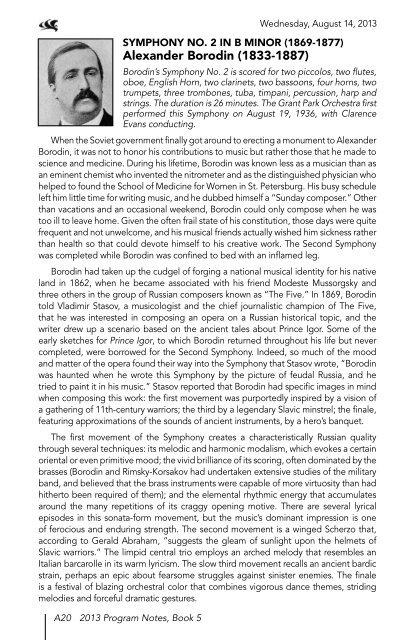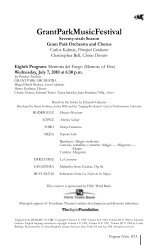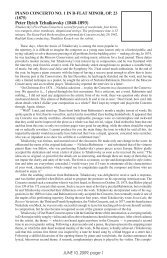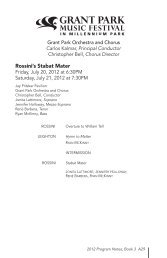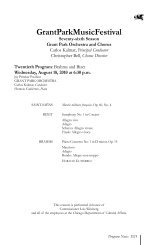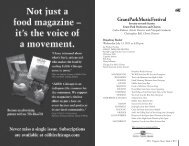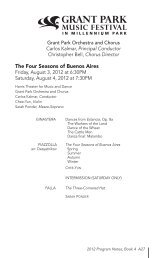Program Notes PDF - The Grant Park Music Festival
Program Notes PDF - The Grant Park Music Festival
Program Notes PDF - The Grant Park Music Festival
You also want an ePaper? Increase the reach of your titles
YUMPU automatically turns print PDFs into web optimized ePapers that Google loves.
Symphony No. 2 in B minor (1869-1877)<br />
Alexander Borodin (1833-1887)<br />
Borodin’s Symphony No. 2 is scored for two piccolos, two flutes,<br />
oboe, English Horn, two clarinets, two bassoons, four horns, two<br />
trumpets, three trombones, tuba, timpani, percussion, harp and<br />
strings. <strong>The</strong> duration is 26 minutes. <strong>The</strong> <strong>Grant</strong> <strong>Park</strong> Orchestra first<br />
performed this Symphony on August 19, 1936, with Clarence<br />
Evans conducting.<br />
When the Soviet government finally got around to erecting a monument to Alexander<br />
Borodin, it was not to honor his contributions to music but rather those that he made to<br />
science and medicine. During his lifetime, Borodin was known less as a musician than as<br />
an eminent chemist who invented the nitrometer and as the distinguished physician who<br />
helped to found the School of Medicine for Women in St. Petersburg. His busy schedule<br />
left him little time for writing music, and he dubbed himself a “Sunday composer.” Other<br />
than vacations and an occasional weekend, Borodin could only compose when he was<br />
too ill to leave home. Given the often frail state of his constitution, those days were quite<br />
frequent and not unwelcome, and his musical friends actually wished him sickness rather<br />
than health so that could devote himself to his creative work. <strong>The</strong> Second Symphony<br />
was completed while Borodin was confined to bed with an inflamed leg.<br />
Borodin had taken up the cudgel of forging a national musical identity for his native<br />
land in 1862, when he became associated with his friend Modeste Mussorgsky and<br />
three others in the group of Russian composers known as “<strong>The</strong> Five.” In 1869, Borodin<br />
told Vladimir Stasov, a musicologist and the chief journalistic champion of <strong>The</strong> Five,<br />
that he was interested in composing an opera on a Russian historical topic, and the<br />
writer drew up a scenario based on the ancient tales about Prince Igor. Some of the<br />
early sketches for Prince Igor, to which Borodin returned throughout his life but never<br />
completed, were borrowed for the Second Symphony. Indeed, so much of the mood<br />
and matter of the opera found their way into the Symphony that Stasov wrote, “Borodin<br />
was haunted when he wrote this Symphony by the picture of feudal Russia, and he<br />
tried to paint it in his music.” Stasov reported that Borodin had specific images in mind<br />
when composing this work: the first movement was purportedly inspired by a vision of<br />
a gathering of 11th-century warriors; the third by a legendary Slavic minstrel; the finale,<br />
featuring approximations of the sounds of ancient instruments, by a hero’s banquet.<br />
<strong>The</strong> first movement of the Symphony creates a characteristically Russian quality<br />
through several techniques: its melodic and harmonic modalism, which evokes a certain<br />
oriental or even primitive mood; the vivid brilliance of its scoring, often dominated by the<br />
brasses (Borodin and Rimsky-Korsakov had undertaken extensive studies of the military<br />
band, and believed that the brass instruments were capable of more virtuosity than had<br />
hitherto been required of them); and the elemental rhythmic energy that accumulates<br />
around the many repetitions of its craggy opening motive. <strong>The</strong>re are several lyrical<br />
episodes in this sonata-form movement, but the music’s dominant impression is one<br />
of ferocious and enduring strength. <strong>The</strong> second movement is a winged Scherzo that,<br />
according to Gerald Abraham, “suggests the gleam of sunlight upon the helmets of<br />
Slavic warriors.” <strong>The</strong> limpid central trio employs an arched melody that resembles an<br />
Italian barcarolle in its warm lyricism. <strong>The</strong> slow third movement recalls an ancient bardic<br />
strain, perhaps an epic about fearsome struggles against sinister enemies. <strong>The</strong> finale<br />
is a festival of blazing orchestral color that combines vigorous dance themes, striding<br />
melodies and forceful dramatic gestures.<br />
A20 2013 <strong>Program</strong> <strong>Notes</strong>, Book 5<br />
Wednesday, August 14, 2013


